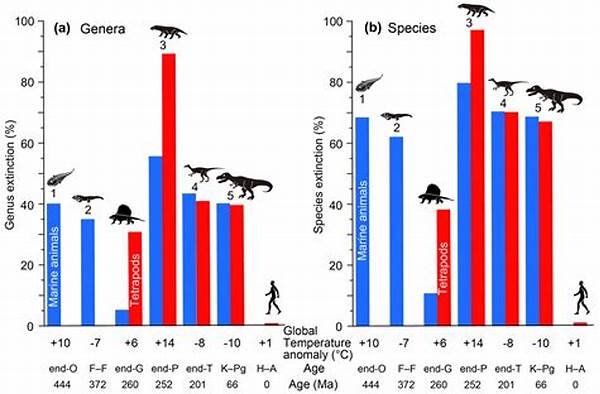Introduction to Military Activities and Species Decline
Military activities have long been acknowledged as a catalyst for various environmental concerns, including the decline of biodiversity. The persistent advancement, testing, and utilization of military technology and resources often lead to unintended consequences for local ecosystems. As such activities intensify globally, the unintended repercussions on flora and fauna are often significant. The phenomenon of military activities causing species decline is increasingly becoming a focal point for ecologists and conservationists. The ecological footprint left by military exercises, pollution from military machinery, and habitat destruction all play pivotal roles in the reduction of species diversity.
During conflicts, natural habitats are frequently altered or destroyed, disrupting the intricate balance of ecosystems. The deployment of heavy military equipment results in soil compaction, leading to altered water channels and drainage patterns detrimental to terrestrial and aquatic species alike. Additionally, unexploded ordnance and landmines render vast tracts of land uninhabitable, pushing several species towards the brink of extinction. These factors, intertwined with pollution and resource depletion, underscore the role of military activities as a driving force behind species decline.
The complexity of this issue is magnified by the intersection of global security priorities and environmental conservation efforts. Recognizing the imperative for sustainable practices within military operations is crucial in mitigating adverse ecological outcomes. Multi-agency collaborations, involving military, environmental, and governmental bodies, are essential in devising strategies that reconcile defense and ecological conservation objectives for the preservation of biodiversity affected by military activities.
Ecological Impact of Military Exercises
1. Military exercises often lead to habitat destruction, causing numerous species to lose their natural homes. The heavy equipment used in these activities compacts soil and affects water drainage systems, resulting in military activities causing species decline.
2. Pollution from military facilities and vehicles releases toxic substances into ecosystems. This contamination leads to harmful effects on wildlife, disrupting reproductive and survival rates, thereby contributing significantly to military activities causing species decline.
3. The construction and maintenance of military bases require extensive land clearance. This process not only removes vegetation but also displaces or eradicates numerous species, emphasizing the role of military activities causing species decline.
4. Noise pollution from military exercises disrupts the natural behaviors of various species. The constant disturbance affects mating calls and navigation, severely impacting populations and illustrating military activities causing species decline.
5. The issue of unexploded ordnance in former conflict zones poses a significant threat to wildlife. These remnants contribute to habitat unsuitability, exemplifying the ongoing risks of military activities causing species decline.
Habitat Loss Induced by Military Infrastructure
Military infrastructure development often necessitates the transformation of vast natural landscapes into controlled environments suited for defense operations. This transformation leads to a severe contraction of habitats available for endemic species. Military activities causing species decline are particularly evident in areas undergoing significant changes, where forested regions give way to military installations. The clearing of vegetation for runways, deployment zones, and training grounds not only eliminates the shelter and resources species rely on but also fragments what remains of their natural habitat.
Fragmentation restricts movement patterns essential for breeding, foraging, and avoiding predators. Consequently, populations become isolated, reducing genetic diversity and making them more vulnerable to environmental changes and disease. The construction of infrastructures like roads and fences further compounds these effects, creating barriers that disrupt migration routes. These interruptions in ecological continuity profoundly impact species vitality, with specific populations unable to sustain themselves under such constrained circumstances. As military priorities expand, understanding the integral connection between infrastructure development and species decline becomes paramount for sustainable operational planning.
Pollution and Military Activities: A Dual Threat
Pollution resulting from military activities presents a dual threat to natural ecosystems and the species residing within them. Strategic military operations release various pollutants into the environment through their daily activities, contributing to military activities causing species decline. Explosives and ammunition testing introduce heavy metals and other toxic residues into the soil and water systems, adversely affecting plant and animal health. Aquatic ecosystems bear a disproportionate burden as pollutants leach into water bodies, disrupting aquatic food chains, and compromising water quality through contamination of drinking sources for wildlife.
Air pollution from combustion engines and weaponry further exacerbates environmental stressors, impairing air quality and subsequently affecting species that rely on pristine air conditions for survival. Terrestrial species are forced to endure degraded habitats where pollution hinders reproductive success and overall health. Such destructive military activities continue to expand, demonstrating the need for stringent regulatory measures and innovative technological solutions to address pollution and mitigate its impact on species decline.
Case Studies: Global Perspectives on Military Environmental Impact
1. Vietnam’s tropical ecosystems faced long-term damage from defoliants used during conflict. The resulting military activities caused species decline, highlighting the extensive repercussions of chemical warfare on both plant and animal life.
2. In the Middle East, military activities in sensitive desert habitats disturb traditional migratory routes of species such as gazelles, exemplifying how military activities cause species decline in fragile ecosystems.
3. Island ecosystems, like the Pacific’s pristine environments, suffer from military installments. The introduction of invasive species and habitat modification illuminate the global issue of military activities causing species decline.
4. European training grounds often occupy former wilderness areas. The intensive military utilization results in habitat fragmentation, driving home the reality of military activities causing species decline within biodiversity-rich regions.
5. In Africa, conflicts over natural resources ignite military incursions into conservation areas. The ensuing environmental disruption underscores the threat of military activities causing species decline, particularly among endangered species.
6. North America’s military testing sites have seen the decline of endemic prairie species due to habitat conversion and pollution. These transformations highlight the regional impact of military activities causing species decline.
7. South American military bases within rainforest ecosystems present significant biodiversity threats. Deforestation and human intrusion for military purposes underscore the broader implications of military activities causing species decline.
8. Antarctica’s designation as a peace zone has prevented military installations, serving as a testament to avoiding military activities causing species decline in vulnerable environments.
9. Coastal temperate regions suffer from naval exercises, where sonar interference disrupts marine life communication, illustrating how military activities cause species decline in oceanic ecosystems.
10. The Arctic, with its sensitive habitats, faces increasing military interest due to strategic geopolitical positioning. Operations pose a tangible threat of military activities causing species decline in polar regions.
Balancing Security and Conservation
Efforts to balance the duality of military efficacy and ecological sensitivity are crucial in addressing the pressing issue of military activities causing species decline. Strategic environmental assessments should be embedded within military planning processes to ensure that conservation goals are aligned with security strategies. By understanding the ecological ramifications of military engagements, institutions can work towards minimizing their negative impacts.
Moreover, adopting sustainable technologies and green practices within military operations can serve as a proactive approach to reducing ecological footprints. The development of policies that prioritize environmental protection in military contexts not only fosters biodiversity but also ensures that military readiness is conducted responsibly. By establishing interdisciplinary collaborations between military defense agencies and environmental organizations, effective frameworks can be designed to mitigate the adverse impacts of military activities on species while maintaining operational capabilities.
Conclusion
Recognizing the significant role military activities play in species decline is imperative for fostering sustainable environmental policies. As this discourse advances, the integration of ecological consciousness within defense strategies remains paramount. The degradation wrought by such activities has far-reaching consequences on global biodiversity. Understanding the intricate relationships between military actions and ecosystem health equips policymakers and military leaders to enact informed decisions that balance national security interests with environmental stewardship. Addressing the environmental externalities of military activities will pave the way for innovative solutions to safeguard biodiversity, ensuring the preservation of the planet’s rich biological heritage for generations to come.





